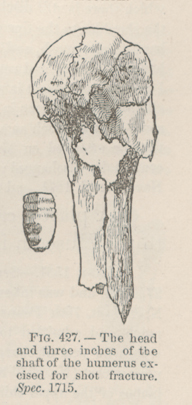Title: F——, Martin
Source text: The Medical and Surgical History of the War of the Rebellion. (1861-65.), Part 2, Volume 2 (Washington, DC: Government Printing Office, 1876), 551.
Civil War Washington ID: med.d2e31149
TEI/XML: med.d2e31149.xml
CASE 1528.—Private Martin F——, Co. I, 8th Illinois Cavalry, aged 20 years, was wounded at Jack's Shop, near Rochelle, Virginia, on September 22, 1863. and was admitted into the hospital of the Cavalry Corps. Surgeon A. Hard, U. S. V., transmitted the following history: "F—— was shot in the shoulder by a minié ball; he was stooping forward in the act of firing when he received the wound, the regiment being dismounted as skirmishers. A wet cloth or lint only was applied to the wound on the field. He was brought to Culpeper, some thirty miles, on the 23d, and was examined in presence of Surgeons Pancoast, medical director of the Cavalry Corps; Beck, surgeon-in-chief of the 1st Cavalry Brigade; Mitchell, in charge of Corps Hospital, and Acting Assistant Surgeons Rogers and Bliss. There was a unanimous decision in favor of resection. In their presence I performed the operation, making a longitudinal incision through the deltoid muscle, opening the joint with the scalpel, turning out the head of the bone and sawing it off as near the injured portion as possible, as the specimen will show. Only one small arterial branch required ligating. The wound was closed by sutures and adhesive straps, and no lint was inserted; this, in my judgment, being the better plan to pursue. Chloroform was employed during the operation I have placed the ball in the specimen as nearly in the position in which it was found as could be arrived at." The specimen (FIG. 427) consists of the head and three inches of the shaft of the humerus, perforated through the surgical neck by a conoidal ball, and excised. The articular surface has sustained no loss of substance, but two fissures run through it, and another follows the line of the anatomical neck. The remainder of the specimen is much comminuted. Two days after the operation, the patient was transferred to Stanton Hospital, Washington. Acting Assistant Surgeon C. H. Osborne noted: "Condition of patient on admission was weak; wound suppurating freely; granulations healthy. November 1st, wound healing finely; appetite good; passive motion to be diligently employed. December 21st, wound entirely healed, with considerable mobility of the shoulder-joint; no fragments of bone were discharged during treatment; prospect flattering of recovery with a useful limb." The patient was furloughed in December; was readmitted, and finally discharged from service April 6, 1864, and pensioned. Assistant Surgeon T. W. Stull, 8th Illinois Cavalry, certified that F—— was wounded "by a musket ball which fractured the head and neck of the humerus of the right arm, rendering it necessary to resect at the shoulder joint." Examiner N. E. Ballou, of Illinois, January 10, 1867, reported: "Gunshot wound of the right shoulder, in which resection was had and four inches of the bone removed. The right arm is wholly useless for manual labor; there are issues on each side of the shoulder which discharge large quantities of pus." In his biennial report, September 4, 1873, Dr. Ballou makes no mention of the issues, but states that "the arm is shortened and is incapable of use." This soldier received his pension on December 4, 1873.
